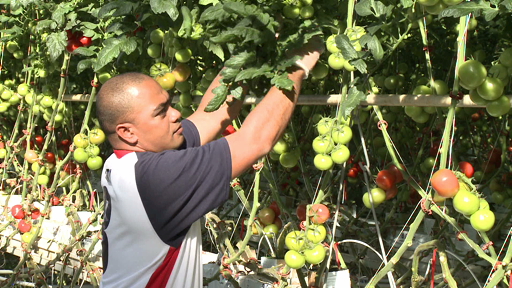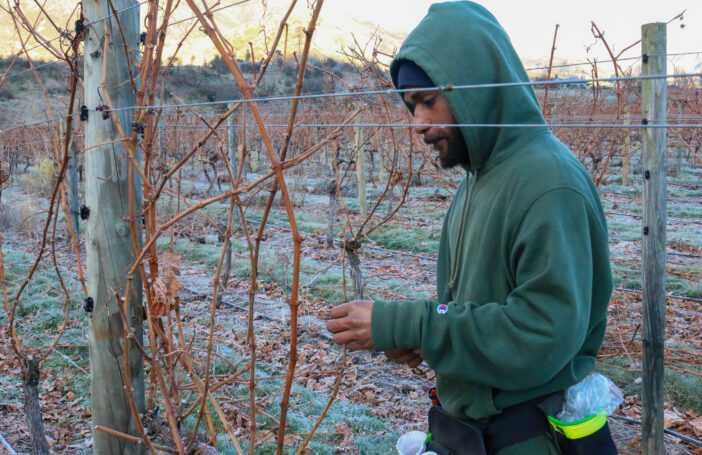The Seasonal Worker Program (SWP) continues to grow, but remains a tiny scheme. This year there might be some 2,600 Pacific islanders picking fruit and vegetables in Australia under the scheme. That’s a small number. The sector employs over 75,000 horticultural workers every year. Some 40,000 or more backpackers pick fruit every year. The parallel New Zealand scheme went almost straight to 8,000, and is now capped at 9,000. So why is the SWP so small and what can be done to expand it?
Last year, the two of us conducted a survey of Australian employers to find out their views on the Seasonal Worker Program. One of us carried out a similar survey with Danielle Hay back in 2011. That survey was good, but this one is better, and bigger, and more recent. We interviewed more growers. We spoke to industry associations. And, this time, there was a larger body of employers with experience of seasonal workers to talk to.
Some of our findings confirmed what we learnt in 2011. Only slightly more than half the growers had heard of the SWP. Given that it has been running since 2009, when the scheme was first introduced as a pilot, that is depressing. Of those growers who had heard of it, two-thirds said that they didn’t use it simply because they had “no need” for it. 14% said it was too costly, and 13% said too risky. Those are very similar numbers to the ones we obtained in 2011. There are also problems with the reputation of the scheme. Among employers in the horticulture sector in general, 62% say that the reputation of the scheme is average or below average.
It’s not all doom and gloom. One quarter of growers say that they would be open to taking on Pacific workers in the next 12 months. Among growers who have used the scheme, two-thirds rate the scheme as above average or excellent. And those who have used the scheme rate Pacific seasonal workers as much more dependable, enthusiastic and productive than either backpackers or locals. We also learnt a lot from the survey about which employers are more likely to use the SWP: much larger ones; from Queensland, WA or Victoria; and those harvesting crops with longer growing seasons.
The other good news is that a scheme introduced by Labor now has bipartisan backing. Foreign Minister Julie Bishop has committed to removing bottlenecks that might be impeding the scheme.
So what can be done to save the SWP from irrelevance? Relying on growth in the increments of several hundred a year is not enough. As the World Bank has set out [pdf], a reasonable expectation for the size of the SWP is 40,000 workers every year. Not 2,000, 3,000 or 4,000, but 40,000. In this survey, we asked employers who used the scheme what they thought would make the SWP more attractive. The most common answers provide a good reform menu.
Employers want to shift travel costs (international and domestic) to employees. They don’t want the responsibility of organising accommodation. They would like reporting requirements relaxed, the minimum work requirement reduced, and the farcical superannuation arrangements changed. (At the moment, super accounts need to be set up at the start of the season, and are then drawn down at the end.) They want labour market testing obligations (which tend to flood employers with applications sent purely to satisfy dole requirements) reduced, and pastoral care requirements relaxed.
Essentially, what employers are telling us is that the SWP is not only over-regulated but too generous. That’s consistent with the Pacific experience: it is well-known most islanders want to work in Australia rather than New Zealand. We pay them much more, with a far higher minimum wage. Essentially, there needs to be a trade-off. The scheme has to be made cheaper to employers to get them to use it. There’s room to do that, and still keep the scheme at least as profitable to Pacific workers as its New Zealand counterpart. Not everything on the employers’ wish list might be actionable, but most items are.
The other reform challenge the survey clearly points to is the need to level the playing field for seasonal workers. Four out of five employers think that illegal labour is used in the sector. And the number of backpackers in the sector has grown astronomically since the 2006 reform that gave backpackers a second-year visa if they worked on a farm. The competition is not between seasonal workers and Australians for jobs. It is between seasonal workers and backpackers, or seasonal workers and illegal workers. Australians get an automatic preference over seasonal workers, but there is no market testing for backpackers or illegal labourers. The reforms that would do most to expand the SWP are :(a) changing the second-year backpacker visa condition (for example, making it a consequence of three months of any work, not just those currently specified, namely agriculture, forestry, fishing, mining and construction); and (b) cracking down on illegal labour, as New Zealand did prior to the introduction of its scheme.
We’ll be discussing our report – Seasonal Worker Program: demand-side constraints and suggested reforms [pdf] – today at ANU. We are grateful to the World Bank Vice President for East Asia and the Pacific, Axel van Trotsenburg, for agreeing to launch the report, and also to the government and growers’ representatives who will be offering their perspectives.
The SWP is a worthwhile scheme, but the biggest risk it faces is that of irrelevance. The implementation of the reforms outlined in our report, based as they are on the views of employers across the horticultural sector, would remove the Seasonal Worker Program from the periphery, and make it central both to the future of horticulture in Australia and to the development of the Pacific.
Jesse Doyle is a Labour Migration Specialist with the World Bank and Professor Stephen Howes is Director of the ANU Development Policy Centre. Click here for more detail about the launch, and here [pdf] for the report.






Incredible post.. i agree with Tess Newton Cain on pre-deployment training and post-deployment mentoring on investment. very important.
Thanks for this post, which provides some useful insight into one part of this issue. I think there is an ongoing concern that the challenges of ‘Whole of Government’ approaches can lead to important things falling between the cracks and the issue of pastoral care is one such item (maybe it’s just me that has that ongoing concern although I doubt it). Attention to pastoral care (which I think can be extended to include pre-deployment training and post-deployment mentoring on investment) is important and needs to be mandated and monitored. There are significant reputational risks in not addressing pastoral care issues as demonstrated recently in relation to a (generally flaky) news item relating to alleged mistreatment of SWP workers from Vanuatu which made it from Yumi Toktok Stret to the Prime Minister’s Office in a matter of hours if that.